The Daily Northwestern
8 SPORTS/Sofball
Wildcats open the season with three wins

VIDEO/Campus reading
Scan here to learn why students aren’t reading for fun anymore
8 OPINION/Spontaneity
Hernandez Gonzalez: Be spontaneous in life

8 SPORTS/Sofball
Wildcats open the season with three wins

VIDEO/Campus reading
Scan here to learn why students aren’t reading for fun anymore
8 OPINION/Spontaneity
Hernandez Gonzalez: Be spontaneous in life
Colectivo workers allege a “toxic” workplace culture at the Evanston cafe and unresponsive management.
Tese reports contrast with the cafe’s pro-worker image.

By CASEY HE and SHREYA SRINIVASAN daily senior staffers @caseeey_he / @shreyasrin
Content warning: Tis story mentions sexual harassment and racism.
As Mackenzie Ridenour and their coworkers wiped down counters, washed dishes and chated about New Year’s Eve plans during the closing shif on Dec. 29, a coworker approached Ridenour, the shif leader.
Te coworker felt the store manager, Ridenour’s superior, treated her unfairly. He blamed her for minor mistakes at work — even ones that weren’t hers, Ridenour
recalled. Te coworker said the manager also complained behind her back that she never took closing shifs but didn’t assign her any, Ridenour said.
Ridenour helped their coworker f le a complaint against the manager through Colectivo’s routine incident reporting system as the rest of the workers fnished closing.
Te workers were scheduled to fnish by 7 p.m. but clocked out at 7:27 that night. A week later, Colectivo fred Ridenour afer two years at the Evanston cafe.
“Because I helped someone with an incident report, I’m geting fred,” Ridenour said. “Not a write-up, not a tsk-tsk. Nothing. Immediately fred.”
According to an initial termination report obtained by
By JANELLE MELLA daily senior staffer
@janelle_mella
McCormick junior James
La Fayette Jr. and Weinberg
sophomore Jamal Omoniyi won the Associated Student Government presidential election and will serve as the next ASG co-presidents.
There were 1 , 836 student votes cast, a 54 5% increase from the 1 , 188 total voters in the 2024 ASG presidential election. The voting was based on a ranked-choice system.
La Fayette Jr. said the election was “very tedious,” especially while balancing homework and studying for midterms. He added that this year’s election was more challenging due to the larger number of candidates.
Four candidate teams ran this election cycle — a number not seen since the 2013 ASG presidential election. It has typically ranged from one to two.
La Fayette Jr. and Omoniyi credited their campaign’s success to the structure and support of their campaign team, particularly the ambassadors
they had representing each NU school. La Fayette Jr. added that what ultimately pushed him to run for president was this support.
“I’m not running just because I want to be president, but because I truly feel like I can help serve these student groups who have reached out to me,” La Fayette Jr. said. “Getting that onthe-ground support from day one was really helpful.”
The two also stressed the importance of working with groups that supported them,
» See ASG RESULTS , page 9

Te Daily, the reasons for Ridenour’s fring included time thef — spending work hours on non-work activities — falsifcation of complaints and violation of harassment complaint policy.
Te incident was the latest of a string of issues workers said they’ve had with the current store manager since he joined the Evanston cafe in late 2023, as well as the cafe chain’s upper management. Colectivo operates 21 cafes, six of which are in the Chicago area.
Interviews with seven current and former employees and internal communications obtained by Te Daily reveal that the chain has faced a host of mismanagement
By SHUN GRAVES daily senior staffer @realshungraves
Unlike some earlier City Council debates, the marquee segment of Sunday’s Evanston candidate forum began with Mayor Daniel Biss and his challenger, Jeff Boarini, sharing pleasantries.
Yet a palpable acrimony hung in the air of Evanston’s former Second Church of Christ. Ten it struck with a vengeance.
While discussing Evanston’s “weak mayor” governing structure, Boarini lampooned Biss’
leadership. “It’s a rather inverted process here, of being a strong mayor and having a very weak city manager as well,” Boarini said.
The mayor soon chastised his challenger for launching a “snide atack.” Biss then began an impassioned defense — and blasted Boarini for taking a “strong mayor” stance by proposing to take over the city’s 311 services.
Still, the broadsides between the two men vying for Evanston’s top office on April 1 seemed insignifcant compared to multiple ward races where even a pretence of pleasantry never appeared. And beneath
the deeply personal atacks lay a foundational rif between two competing visions for the city. Te batle for the 7th Ward — the site of Ryan Field, ground zero for residents’ frustrations with development — launched the hourslong forum with a bang. “How ofen do you adopt others’ opinions instead of forming your own?” Parielle Davis asked her opponent, Kerry Mundy, over his apparent support for Northwestern’s bid to commercialize a rebuilt Ryan Field. “I make my own decisions, and » See FORUM, page 9
By ISAIAH STEINBERG and MISHA MANJURAN OBEROI daily se(i)r sta,,ers @isaiahstei-.
On the surface, the scene remained largely unchanged from two weeks ago at the Civic Center. Evanston’s City Council, turn by turn, fervently debated the Healthy Buildings Ordinance.
But this time, when the time came for the /nal vote, the council was in full agreement. It would postpone the vote until the next meeting — again.
At the Monday evening rendezvous, Ald. Bobby Burns (5th) and Ald. Jonathan Nieuwsma (4th) led the charge to table the vote.
“I need some basic information about how (the Healthy Buildings Ordinance) is going to be realistically operationalized so I can explain this to my community,” Burns said.
Nieuwsma said he met with Northwestern representatives who convinced him that the University’s concerns about implementing the ordinance were legitimate. Burns said he needed more time to collaborate with stakeholders to determine how the ordinance would be implemented and its impact on property values.
e ordinance would require buildings with more than -0,000 square feet to eliminate on-site emissions and use only renewable energy by -050. It would also apply to city-owned buildings with more than 10,000 square feet.
City Council previously tabled the ordinance on Jan. -. for similar reasons. At that meeting, the divided dais cited vocal opposition to the ordinance and confusion over stakeholders’ role in the implementation process.
e decision to table the ordinance faced less dispute, with key stakeholders’ positions well-known. Evanston/Skokie District 65 and Evanston Township High School District -0- reversed course to support the ordinance, while NU remains skeptical.
A er Deputy City Manager Stephen Ruger presented the council with proposed amendments to the ordinance, dra ed by Nieuwsma and the Building Electri/cation Working Group, councilmembers concurred that they needed more time to consider the amendments before passing the ordinance.

“What I would like to do is have a quick meeting with building owners to say, ‘Okay, now that we know the terms, what’s your reaction to it?’” Burns said. “Does it make these projects more feasible?”
e proposed amendments include establishing a public rulemaking process, including the possibility of contentious carbon credits in Alternative Compliance Pathway Plans, allowing rejections of alternative compliance proposals to be appealed and clarifying that alternative compliance requests will not be “unreasonably denied by the city manager.”
Residents expressed divergent views on the ordinance during public comment. While several NU and Evanston Township High School students advocated for its passage, landlords and realtors raised concerns about the /nancial strain of repairs, tenant displacement
and potential rent spikes.
“ e amount of work required to comply is so expensive that we call this the ‘evict your tenants and raise their rent ordinance,’” landlord Aron Bornstein said.
Later in the meeting, Nieuwsma countered that the alternative compliance pathways would help property owners shoulder the costs of renovations and prevent tenant displacement.
Nieuwsma proposed an amendment that would increase the percentage of /ne revenue that goes to a local decarbonization fund, helping property owners who qualify on a need-basis.
On Sunday, University President Michael Schill published a le er in the Evanston RoundTable promising future NU collaboration on the technical aspects
By ISAIAH STEINBERG
daily se(i)r sta,,er
@
isaiahstei
-.
Seven years. That’s roughly how long the College Board told Medill it would take to develop and implement a brand-new Advanced Placement Journalism class for high school students, according to Medill lecturer and Teach for Chicago Journalism Director Michael Spikes.
That initial communication took place in -0-- . Three years later, the Medill School of Journalism, Media, Integrated Marketing Communications has piloted an AP Seminar module with four local high schools and is planning to begin developing a full AP Journalism curriculum.
In the -0-3 - -0-4 school year, Medill piloted its media-focused module at Chicago-area schools
William Jones College Preparatory High School, Gwendolyn Brooks College Preparatory Academy, Northside College Preparatory High School and James B. Conant High School.
“We got positive feedback from all of the people that worked with it,” Spikes said. “Granted, it’s only the first year, but we saw that students did better in the course.”
Since the pilot program, Spikes said the College Board has informed Medill that it was “super happy with the module.”
The next step, he added, is for the College Board to formally endorse the module and promote it to AP teachers nationwide on its website.
The idea came about when Teach for Chicago Journalism — Medill’s initiative to support
journalism education in local schools — realized that many high school students wanted to take journalism classes but felt pressured to take AP classes instead, Spikes said.
“Medill has had interest over the years, over a long time, in cultivating not only the next generation of journalists through the students we teach here but also in driving high school students to think about journalism as a career,” Spikes said.
Medill approached the College Board with the idea for an AP Journalism course in -0-- . When the College Board told Medill it could take nearly a decade to review a new AP exam and get approval from colleges to accept course credit, the initiative’s leadership pivoted.
Katie Fernandez, Teach for Chicago Journalism’s senior program coordinator, said the College Board suggested starting smaller.
From then on, Medill developed a module teaching media literacy, the modern media ecosystem and journalism’s role in democracy for AP Seminar — a yearlong independent research class required for the AP Capstone Diploma.
AP Seminar students learn interdisciplinary research skills by conducting independent and collaborative research projects, as well as an argumentative paper. Though the curriculum is flexible, teachers often dedicate much of the first semester to teaching the necessary skills to synthesize information and think critically. This first portion of the course typically focuses on one topic for a practice performance task, which is where Medill’s module
comes in.
Because AP Seminar is contentagnostic — meaning teachers can choose practice materials on any topic and students choose the topic of their research — Medill’s practice module aggregates resources for students to analyze to prepare for their performance tasks, Fernandez said.
College Board spokesperson Sara Sympson said the organization looks forward to reviewing the module for final approval.
“We regularly partner with institutions to create and develop courses that we think will be relevant to students and for which they can earn college credit,” she said.
The College Board did not immediately comment on the criteria for the module to be approved for national implementation.
Spikes said he believes Medill’s module will align with the goal of AP Seminar: to introduce high school students to scholarly research and inquiry. Media literacy is fundamental to helping students analyze arguments from multiple perspectives, he added.
Katina Paron, a former program manager for Teach for Chicago Journalism, said high schools should embrace journalism education because it teaches necessary skills such as critical thinking and research.
“Journalism gives young people a seat at the table on issues that affect them,” Paron said.
Paron said she hopes a fullfledged AP Journalism class would introduce students to key topics in modern journalism, including its business model and impact.
Medill sophomore Margarita Williams took AP Seminar in high
school and said she would have taken AP Journalism if she had the opportunity, especially if she could have learned the specifics of Associated Press style –– writing guidelines of professional journalism.
“Even for students who aren’t interested in going into journalism, it would be really great, because AP style is useful outside journalism — pretty much in any writing field,” Williams said.
Williams said an AP Journalism class could help underfunded schools that may not have a newspaper or literary magazine.
Medill sophomore Gabe Shumway said journalism is missing from many high school curriculums, and an AP Journalism course could help students “break the mold” of traditional essay writing.
“I felt like I was going in blind when I tried to do journalism in high school independently, so I would love something like that,” Shumway said.
Currently, Fernandez said Medill is focusing on rolling out the AP Seminar module to a broader audience.
Without any concrete plans for an AP Journalism course, Medill’s goal is to launch the AP Seminar module nationwide this fall. If the launch goes well, Fernandez said she is ready to continue the process toward an AP Journalism class.
“It’s been a slow process,” Fernandez said. “Whenever they’re ready to move forward, we’re just sitting here waiting. We’re ready.”
This is a developing story and will be updated as more information becomes available.
isaiahsteinberg2027@u.northwestern.edu
of the ordinance — including funding — if the council further revised the ordinance. Schill wrote that the city should solidify the implementation process before passing the ordinance, and added that local stakeholders should participate in its revision.
Monday’s decision did not propose a collaboration with NU on the ordinance before the /nal vote. However, according to Burns, it gives stakeholders more time to ruminate on the rami/cations of the ordinance.
“I’d like at least another meeting to /nish up those conversations,” he said. “I’m working to get a yes on this. And so again, we’re close.”
isaiahsteinberg2027@u.northwestern.edu
mishaoberoi2027@u.northwestern.edu
The Daily Northwestern www.dailynorthwestern.com
Editor in Chief Lily Ogburn eic@dailynorthwestern.com
General Manager Stacia Campbell stacia@dailynorthwestern.com
Holly and John Madigan Newsroom
Phone | 847 4$1 3222
Campus desk campus@dailynorthwestern.com
City desk city@dailynorthwestern.com
Sports desk sports@dailynorthwestern.com
Ad Office | 847 4$1 72() spc-compshop@northwestern.edu
THE D,I./ N012HWE42E15 is printed each Wednesday during the academic year, except vacation periods, the two weeks preceding them and once during August, by Students Publishing Co., Inc. of Northwestern University, 1999 Campus Drive, Evanston, IL 60208. All news is published 24/7 online at Dailynorthwestern.com.
First copy of THE D,I./ is free, additional copies are 50 cents. All material published herein, except advertising or where indicated otherwise, is Copyright 2025 THE D,I./ N012HWE42E15 and protected under the “work made for hire” and “periodical publication” clauses of copyright law.
POSTMASTER: Send address changes to THE D,I./ N012HWE42E15, 1999 Campus Drive, Evanston, IL 60208. Subscriptions are $100 for the academic year. THE D,I./ N012HWE42E15 is not responsible for more than one incorrect ad insertion.
Literature Fine
Arts Distro Area
Literature and Arts
Foundational Discipline
SLAVIC 101-8 ARE YOU WHAT YOU SPEAK? LANGUAGE AND POLITICS IN CENTRAL AND EASTERN EUROPE
261
311
369
396


HEART OF EUROPE: POLAND IN THE TWENTIETH CENTURY DOSTOEVSKY RUSSIAN DRAMA LITERARY TRANSLATION ACROSS GENRES
FAIRYTALES AND FOLKLORE POLISH 208-3
INTERMEDIATE POLISH: LANGUAGE AND CULTURE LEARN RUSSIAN WITH EASE: FROM CYRILLIC TO CONVERSATION



INTERMEDIATE RUSSIAN CONTINUING THE JOURNEY: A MODERN RUSSIAN EXPERIENCE ADVANCED RUSSIAN IN CONVERSATIONS










1
allegations, including “inappropriate” behavior from the Evanston store manager, a “toxic” workplace culture and a lack of support from upper management.
Colectivo did not answer The Daily’s questions about the workers’ allegations.
These allegations contrast with the chain’s public image — Colectivo leaders have called their company “a deeply progressive organization,” and its members have been represented by the International Brotherhood of Electrical Workers union since 2021
“(Colectivo) say what they need to say and do certain things on the public scale that look good, that look like they are very proworkers’ rights,” Ridenour said. “They want to look like a collective for Colectivo, and it’s not at all how they actually run their stores.”
Tensions brew with management
After the current store manager started at the Evanston cafe in late complaints from workers soon followed.
The manager scheduled shorter shifts for workers, former employees told The Daily. They also recalled his favoritism toward certain workers and other poor management decisions.
unprofessional. Diana and another female former Colectivo employee, who spoke to The Daily on the condition of anonymity in fear of retaliation, said the manager would send them non-work related messages on the messaging platform for Colectivo employees. Several former employees also recalled the manager bringing gifts to some
into per-
between workers. “It strange to
“Tey want to look like a collective for Colectivo, and it’s not at all how they actually run their stores.” ”
- MACKENZIE RIDENOUR, former Colectivo employee
complaint against the store manager.
In January 2024 , Colectivo implemented a new anonymous incident reporting system for employees to report ethics violations. In an email to staff, Colectivo’s Vice President of People said the system aims to provide “a work environment where employees feel safe.” 15 , Ridenour submitted an incident report. It alleged the manager’s handling of the customer’s sexual harassment the previous day made workers at the store feel “unsafe,” “uncomfortable” and hesitant about reporting similar issues in the future.

Diana, a former Colectivo employee who requested to go by a pseudonym in fear of retaliation from management, said the current manager immediately began cutting workers’ shifts and was inconsiderate of workers’ schedules and concerns.
Along with the reduced hours, Diana recalled a “very strict workplace” when the current manager took over. Several people were fired in the weeks that followed for seemingly minor infractions, Diana said.
“I felt like people were getting, I don’t know what’s the word for it, hazed? Almost like a hazing from the new manager,” Diana said. “He was just very strict, and he was very profit-centered.”
Ridenour also remembered similar incidents, which led them to suspect that employees who were vocal about workplace issues were being targeted by Colectivo’s upper management. After they brought several issues to the Colectivo union’s attention, a union representative told them to be careful and avoid putting their employment at risk.
IBEW Local 1220 , the union that represents Colectivo workers, did not respond to emails and a phone call asking for comment.
ing the shop, spilling into “inappropriate” workplace
”
him commenting on your personal life, especially from the standpoint of a manager that’s cutting your hours and that you’re not really close with or even liking very much,” Diana said.
The store manager did not respond to multiple emails asking for comment.
Issues with the current manager came to a head in spring of 2024 . When a customer made a slew of sexualizing comments to the cashier, she brought the issue to the manager’s attention. He dismissed her complaint, saying the customer was a store regular, Ridenour recalled the coworker telling them.
After that customer returned in June and made similar comments to the same worker, the actions caught the attention of Ridenour. When Ridenour spoke to their coworker about the comments, she said she had already reported the issue to the store manager to no effect.
“He just walked away,” Ridenour recalled their coworker saying about the interaction with the manager. “He didn’t even give it a full conversation. He just dismissed it so quickly.”
That day, the cafe hosted representatives from Colectivo’s human resources department. Ridenour decided to report the issue to them directly. They recall the representatives’ initial response as helpful, agreeing to ban the customer and asking if Ridenour wanted to have the
The incident and how their coworkers reacted also led Ridenour to suspect that other workers had similar interactions with the manager. Conversations with their coworkers confirmed the suspicions, Ridenour said.
Of the 20 -odd workers at the store, about five told Ridenour about specific negative experiences with the manager, Ridenour said. The incidents included issues with scheduling and time off, unprofessional behavior and the appearance of special treatment. Several others also mentioned that the manager’s conduct made them feel uncomfortable.
In a June meeting with Colectivo’s management, Ridenour brought up issues they heard from their coworkers, they said. For months after, issues with the store manager persisted, and Colectivo did little to address workers’ concerns, Ridenour said.
In a second incident report in August, Ridenour alleged a “hostile work environment,” where workers were afraid of speaking up in fear of being “ignored” or “bullied” by
The August report landed Ridenour in a meeting with the area manager and HR.
Since early 2024 , area managers for Colectivo’s three districts — Chicago, Milwaukee and
enough to dissuade them from filing a report in the first place, they said.
“We’re trying to go through the routes they want us to use, and every single time we’ve done this, they just go up to these women, and they’re just like, ‘No, I don’t think you really understood what happened,’” Ridenour said. “‘You just didn’t get the joke.’”
Boiling over
After being told during the August meeting that they needed to stop filing incident reports on other employees’ behalf, Ridenour said they tried to step back and encourage coworkers to utilize the reporting system.
Two days after their coworker filed a report on Dec. 29 alleging the manager treated her unfairly, Ridenour said the area manager came to the store to meet with their coworker.
The area manager conducted the meeting on the shop floor, surrounded by guests, according to the coworker’s recounting of the conversation to Ridenour. He dismissed her concerns by saying that the manager doesn’t have a reputation of complaining and she must have misunderstood, Ridenour said.
The response to the complaint frustrated Ridenour, they said. They took the issue to the cafe’s assistant store manager, who contacted the area manager to follow up on the incident.
When Ridenour came to work on Jan. 6 and saw the area manager, they said they immediately knew what might be coming.
In the cafe’s basement — which doubles as the break room and storage — Ridenour found out they were being fired. In addition to other accusations, their initial termination report said Ridenour “coached” their coworker in filing the Dec. 29 incident report against the manager, “influencing its content.” A later termination report struck the time theft and harassment complaint policy violation charges from Ridenour’s record.
“I definitely … after seeing a 19 -year-old cry on the floor two times, lost my resolve a bit to
“Every single time we’ve done this, they just go up to these women, and they’re just like, ‘No, I don’t think you really understood what happened.’”
- MACKENZIE RIDENOUR, former Colectivo employee ”

Ridenour didn’t expect what happened next. The store manager later tried to walk back the decision to ban the customer, Ridenour said.
sonable and friendly to certain employees, called was with the store rather than the workers.
“I defnitely … afer seeing a 19-year-old cry on the foor two times, lost my resolve a bit to just stay out of it.”
- MACKENZIE RIDENOUR, former Colectivo employee

An HR representative also said HR never authorized the banning, which led Ridenour to suspect that management
siding
manager Exhausted by what Ridenour said were repeated dismissal of workplace concerns, Ridenour decided to lodge a
Madison — have been acting as their district’s de facto HR representatives. As a result, they have been weighing in on personnel-related issues alongside a downsized HR team, according to Ridenour.
The area managers, however, are supposed to “support” the store managers, according to Ridenour, which they said creates a conflict of interest.
At the meeting, management and HR “coached” Ridenour on respecting managerial decisions and “avoiding emotionally charged interpretations,” according to their termination report. During the meeting, Ridenour recalled being asked why they were so “angry” with the store manager and told that they reported issues at the cafe “too many times” and should simply “stop caring.”
“I basically started sobbing, just because I was like ‘Wow, they’re not going to do anything,’” Ridenour said. “They think I’m the problem, and none of the rest of it is an issue.”
Ridenour’s experience with the reporting system is not unique. Feeling uncomfortable because of the same manager’s language and behavior toward her, Diana also filed a complaint against him. But she said HR did little to address her concerns since the report didn’t include specific incidents for what she said was an “everyday occurrence.”
For some other workers, the lack of results from the incident reports and fear that the manager would identify the complainant was
just stay out of it,” Ridenour said.
Stained track record
Issues with Colectivo’s management extend beyond the current Evanston location manager. Evanston workers alleged a previous manager, who now supervises a different Chicago area location, was inconsistent and acted in ways they said were “aggressive” and “racist.” Workers at the cafe’s Andersonville location said their location experienced a similar slew of management mishaps.
Macy, a former Colectivo employee who asked to go by a pseudonym due to fear of retaliation from Colectivo, began working at the Evanston cafe in February 2022 . She and several other former Colectivo employees recalled the former manager having a “laid back” and “nonchalant” attitude toward management, causing workers to feel confused and unsupported.
Ridenour, who was also working at the cafe at the time, recalled instances where the manager, who is white, would speak and act differently toward a Black employee, using “slangs” and “cadences” he didn’t use with other workers.
“When he was speaking with her, he would use very different language, and it was obvious enough that her and the people around her were uncomfortable by it,” Ridenour said. The former manager’s inappropriate conduct also extended toward customers, several former
employees said. Macy said the former manager would resort to physical force when dealing with “difficult customers,” and she had witnessed him pinning a customer to the ground. Ridenour also recalled the former manager telling a group of non-white customers to leave
name and pronouns and overall displayed a lack of compassion, he added.
When a coworker requested a family bereavement leave, the manager responded by asking the coworker to find cover for his shifts, the worker said.

contract negotiation, it reflects the disconnect between the company’s progressive image and anti-worker behaviors, Colectivo workers told The Daily.
After workers began organizing in the summer of 2020 , Colectivo’s management responded by hiring the Labor Relations Institute, an Oklahoma-based consultancy whose website offers to help employers “win a union election” and “prevent future unionization efforts,” according to Urban Milwaukee. LRI did not respond to an email asking for comment.
Management also sent emails to Colectivo employees to disapprove of the unionizing effort. In one letter from August 2020 , thenCEO Dan Hurdle wrote that he and the company’s three founders “fear that a union would have a profoundly negative impact on our company Culture.”
Colectivo’s bargaining team that lasted about a year, as “disagreements were everywhere,” and Colectivo’s negotiators would not budge on seemingly minor items.
One particular point of contention, Heren said, was a clause to prevent discrimination from Colectivo and the union based on protected classes, including race and sexual orientation. Colectivo initially did not want to include specific classes, he said, and only relented after the union workers found similar language in the company’s employee handbook.
“It was just the most ridiculous back-andforth,” Heren said. “It almost felt like they were trying to be as frustrating as possible.”
Ridenour, who joined Colectivo in December 2022 , recalled HR representatives boasting about the union and ongoing contract negotiation when they were onboarding for the job.
But once they began working at the store, they were told not to discuss the union at work.
“But ultimately, my experience with that in Evanston was that you voice your complaint or concerns, and it’s a total waste and nothing happens.”
the store as they were waiting for their orders.
Employees reported these incidents to Colectivo’s HR department, but it did little to address the circumstances, Ridenour said. They said the Black employee was abruptly promoted to shift leader as she was considering reporting the manager. Other employees’ complaints also went nowhere, Ridenour added.
The former store manager did not respond to emails asking for comment.
“I think (Colectivo’s management) like to say that they are there for employees and coworkers to come to. But ultimately, my experience with that in Evanston was that you voice your complaint or concerns, and it’s a total waste and nothing happens,” said the former Colectivo Evanston employee who spoke to The Daily anonymously. “I believe the same thing happened with the incidences of racism.”
Near the end of 2023 , Colectivo transferred the former manager to another Chicago area location.
But some employees viewed the transfer — rather than a more severe form of discipline — as consistent with Colectivo’s tendency to sweep management issues under the rug.
“The way the (area) manager made it sound was that, ‘Well, (the former manager)’s never going to be able to get better here because everyone just doesn’t like him,’” Ridenour said. “So they’re trying to say that we were the problem — the coworkers were the problem.”
At Colectivo’s Andersonville location, management problems were also simmering. The store manager’s management style was inconsistent and often mood-driven, a former employee at the location told The Daily on the condition of anonymity due to fear of retaliation from management. The manager was also unwilling to address workers by their current
- FORMER COLECTIVO EMPLOYEE ”
“I basically messaged (the manager) like, ‘Hey, he’s not really able to be at the phone. He’s dealing with the obvious family stuff. I will take care of his shifts,’” the worker recalled.
“And she kind of was just like, ‘Okay, great, sounds good.’”
He said the coworker eventually quit because of the episode.
The store manager for the Andersonville cafe did not respond to emails asking for comment.
Another Colectivo employee, who asked to remain anonymous due to fear of retaliation from management, said the former employee’s experience was not uncommon.
But the worker said they saw many of the issues at their cafe as coming from Colectivo’s upper management rather than the store manager.
In one incident in October 2024 , the worker said the cafe was not allowed to close when its espresso machine broke. She said upper management told the store manager to keep the cafe open despite it not being able to serve many drinks on the menu, which she said made the workers feel unheard and unsupported by management.
The incident reflects a larger trend at the cafe chain, the worker said. They added that executives are becoming increasingly focused on pursuing expansions and profits, which has come at workers’ expense in the form of unrealistic expectations and benefit cuts.
Bitter negotiations
In 2021 , Colectivo workers made headlines for unionizing. About 400 workers joined IBEW. The union, however, formed only after a contentious battle between workers and Colectivo management. Along with the ensuing
In another email from early 2021 , management discredited the union organizers by suggesting the majority of them, including one who said she was laid off due to her organizing efforts, were no longer with the company, the organizer told Defector.
Colectivo protested to the National Labor Relations Board to exclude several ballots in a March 2021 unionization vote, while the organizers pushed to have them opened and counted. In August, the NLRB ruled for union organizers and allowed Colectivo employees to join the IBEW union later that month.
Following the results, Colectivo leaders said in a statement that they were “disappointed” by the results but would bargain with the union
tract bargaining team, “(Colectivo’s
“They appealed it so many times that the NLRB single line.” The Colectivo
“It was like a radical thing when we wore buttons that said ‘vote yes’ on the union contract. It was a radical thing that we talked about the union at work,” Ridenour said. “It was very much like, ‘No, we just tell people that we have a union, and we’re proud of unions. Don’t bring that to work.’”
After two years at Colectivo’s Andersonville location, Heren said he ran into a string of scheduling issues, a “last straw” that made him leave the cafe in September 2023
His experience working at the cafe and on

”“Tey love to present as this progressive company that sells pride merch with the rainbow on it every Pride Month. But every June, I love to talk about how they didn’t want to explicitly list sexual orientation as a protected class in their union contract.”
- ZACARY HEREN, former Colectivo employee
bow on it every Pride Month,” Heren said. “But every June, I love to talk how they didn’t their union
union bargaining team, consisting of six Colectivo workers and several representatives from the IBEW union, began contract negotiations with Colectivo in June 2022 , Heren said.
He recalled protracted meetings with

Macy left Colectivo after almost one year. The issues with the now-former manager at the Evanston cafe persisted after workers raised concerns to upper management, which contributed to her decision to quit, she said.
Although Ridenour had been contemplating leaving Colectivo, their sudden termination still came as a shock to them and their coworkers, they said.
“Instead of having two weeks to say bye to all of these people, I had two minutes, and it was just whoever was working there,” Ridenour said.
Still, the outpouring of support from their coworkers left Ridenour with a mixed feeling of relief, nervousness and vindication.
“This has all been really hard and tiring — standing up for them and fighting for them,” Ridenour said, choking up. “That’s exhausting. So, it was really nice hearing all these people just being like, ‘Thank you for teaching me to stand up for myself and believing in me.’ I felt a little less scared about leaving them.”
Ridenour initially applied for a job at Colectivo because of its appeal as a “pro-worker” and “ethical” company, they said.
With Colectivo in the rearview, they said they are moving on from working at large cafe chains, away from the corporate “baloney” they have been dealing with for the past two years.
“I’m definitely looking forward to working at an actual small business,” Ridenour said. “Not one that just paints itself as one.”
caseyhe2026@u.northwestern.edu
shreyasrinivasan2026@u.northwestern.edu
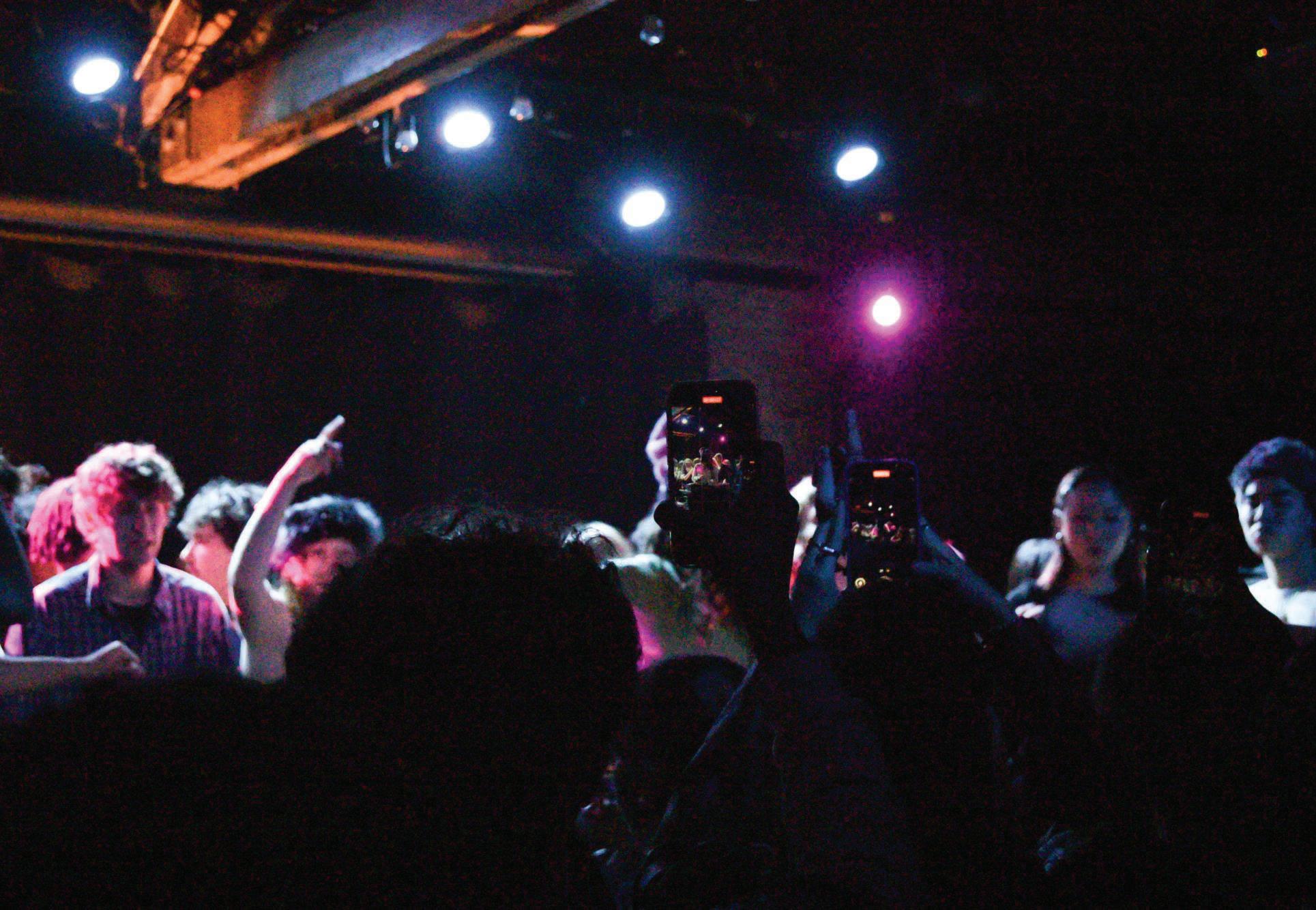

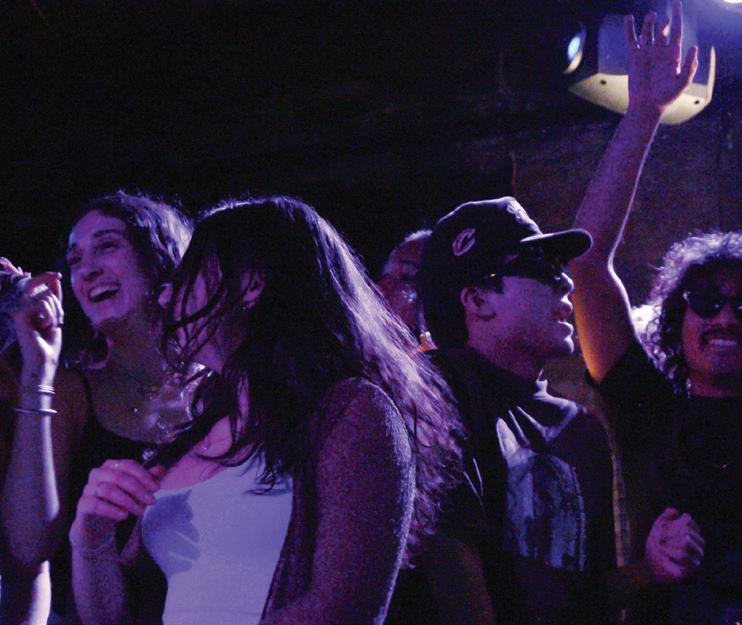
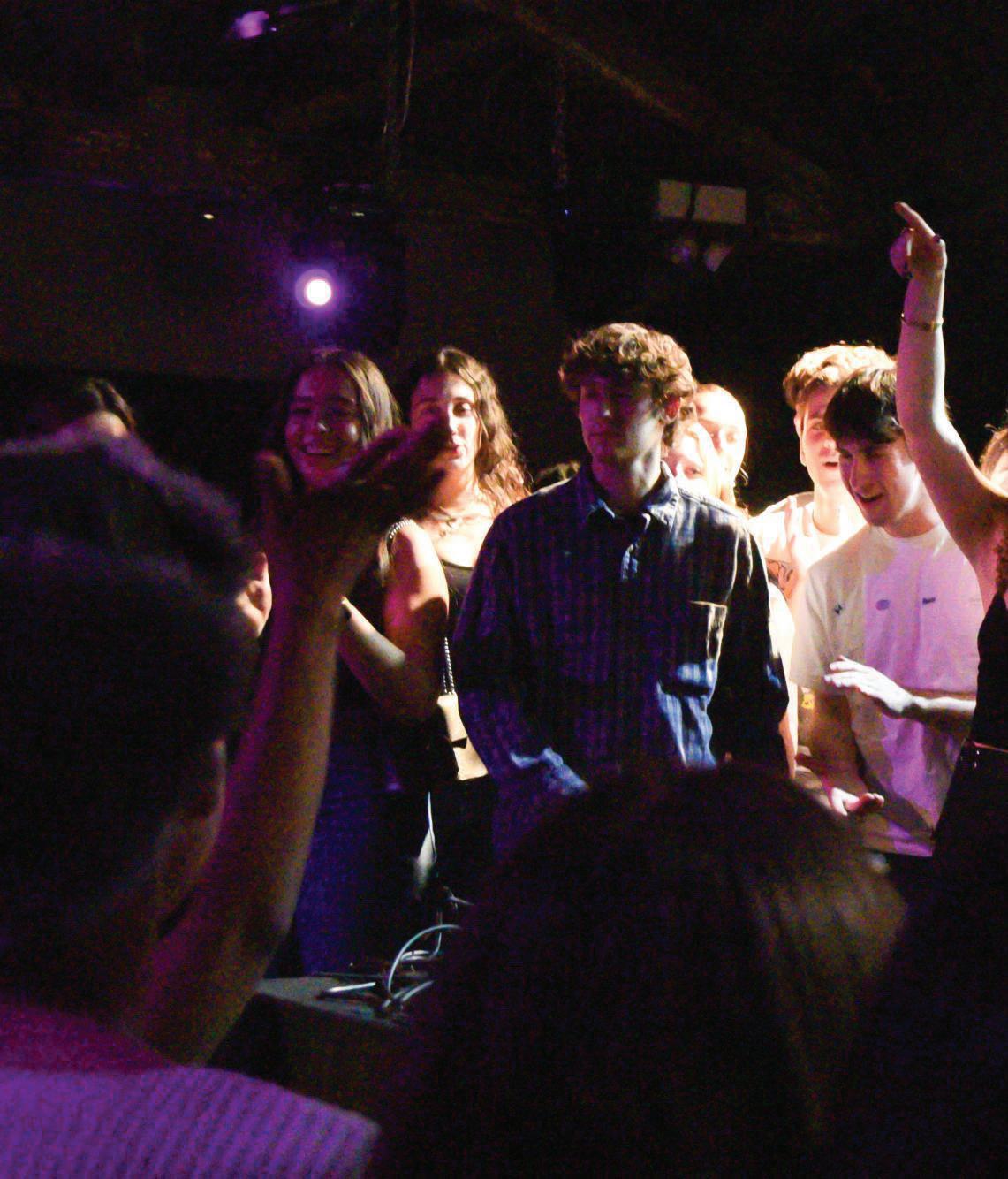


By KATE POLLOT the da&l( )orth,e-ter)
@kpollot.7.52
A&O Productions turned Evanston SPACE into a rave ursday night during the entertainment programming student group’s annual bene t concert. A&O dubbed this year’s event e Icebox, featuring performances from two DJs. e event’s bene ciary was Interfaith Action of Evanston, an organization focused on advocacy and community service run by local faith leaders. e organization manages facilities such as soup kitchens and an overnight shelter. In lieu of paying for tickets, A&O encouraged a endees to make a $5 donation to the charity.
A&O selected Interfaith as the recipient a er an executive member grew close to a member of the charity, said Weinberg senior and A&O co-Chair Sereniti
Williams.
“We thought that it was a good cause and someone we would love to be supporting, especially during the winter months when having access to a shelter is super vital,” Williams said.
Bienen senior Lucy Rubinstein, under her stage name r00bies4ever, opened the concert, exciting the crowd as attendees continued to trickle in. Her set was inspired by a variety of genres like R&B, hard groove and UK garage, according to Rubinstein.
Rubinstein, who plays venues ranging from house parties to nightclubs such as smartbar and Smoke & Mirrors, said the event was a night she will “never forget.”
“As soon as I stepped o the stage, I knew this was one of my favorite sets I’ve ever played,” Rubinstein said. “ e energy in the room was unlike anything I’ve experienced at Northwestern.”
Emcees encouraged students to dance with both DJs as audience members packed the stage at the
sold-out event.
Medill senior and A&O Concert Chair Eva Putnam said she led the creative vision for the event with the assistance of both the concert committee and production team.
“We wanted to create something where people in the audience felt very connected to the music and the performer,” Putnam said.
Putnam said the event was inspired by Boiler Room, a concert producing and broadcasting company. Boiler Room hosts events at which attendees stand on the same level as the DJs instead of below them, a setup Putnam said interested her.
For Rubinstein, the dancers in the crowd were part of what made the night special.
“ e fact that all of the attendees were super open to my music, curious to see what I was going to play, and then let go and dance, I wasn’t quite expecting that,” Rubinstein said.
Rubinstein was followed by headliner DJ
Anastazja, a recent graduate of the University of Southern California. A&O chose her for the event due to her aesthetic and “really interesting sound,” Putman said.
Anastazja’s genre-crossing set included Brazilian house music as well as Gwen Stefani’s “Hollaback Girl.”
“In general, I would label myself as open format,” Anastazja said. “I don’t really have a limitation when it comes to style.”
Anastazja said she enjoyed returning to her roots of playing for a college crowd and playing near her home city of Chicago.
Like Rubinstein, Anastazja also found the energy of the crowd memorable.
“I actually haven’t played to a crowd that danced to almost every song in a while, so that was also something I was really happy about,” Anastazja said.
katepollot2024@u.northwestern.edu
By DALTON HANNA
t&e dail, -.rt&wester@daltonhanna06
Filming horror movies and starring in television shows, Evanston’s own Sophie atcher had a busy year in Hollywood.
e 2.-year-old actress shot the third season of the hit show “Yellowjackets,” which premieres this Valentine’s Day. e show follows a group of teenage girls forced to survive in the wilderness a er a plane crash. atcher plays the younger counterpart of the character Natalie (Julie e Lewis). Aside from “Yellowjackets,” atcher also starred in two critically acclaimed horror lms released in the past few months: “Heretic” and “Companion.” atcher sat down with e Daily to discuss her recent roles and upbringing in Evanston.
is interview has been lightly edited for brevity and clarity.
e Daily: Firstly, I’d love to discuss your Evanston roots. Was there a particular moment or experience in Evanston, like a school play, a mentor or a local production, that made you feel like acting was something you wanted to pursue seriously?
atcher: I grew up in Lake Forest, and then I moved to Evanston in eighth grade. I was living on Judson (Avenue), so I went to Nichols Middle School. I went there for a bit, but then I had to be homeschooled because I was doing a play at Writers eatre. Chicago theatre in
general is such a beautiful, tight-knit community, and every time I come back, I try to see a play. I’m still really close with everybody, and I’m so thankful for that.
I was also taking acting classes at ATC (Actors Training Center) in Wilme e, and that was also a great place for building community. It was really special to nd other kids who took it (acting) as seriously as I did. ey have amazing workshops. It is the best way to get into a professional se ing without professionally acting. ey treat you like adults; that really prepared me.
e Daily: What’s a piece of advice you’d give to aspiring actors currently in school here?
atcher: With acting in general, it’s important to build community and have people that you can work with and trust to create your own projects. My advice would be: Film something with your friends, even if it’s a scene, and study yourself with other people. at’s really informative. Help with self-tapes. You learn a lot by watching a friend do a self-tape, even if it’s not for an on-camera scene. It’s important to know sometimes how it translates without being too self-aware.
You have all of the power, and if you’re not booking anything, you’re living in a time where it’s so easy to just create your own things. I mean, Sean Baker made “Tangerine” on his phone. You really can do anything you want as long as you have other people supporting you.
e Daily: Has there been a scene or character in one of your projects that challenged you in a way you didn’t expect? What did you take away from that experience?
atcher: Every role that I’ve played so far has been
really challenging. My rst scary role was playing Cee in “Prospect” with Pedro Pascal and JD (Jay Duplass) because so much of it was dependent on reactions, and I didn’t have a lot of dialogue. Just going in with false con dence, until you actually believe you’re con dent, is the most important thing.
It’s interesting — on “Yellowjackets,” I’m learning a lot from playing Natalie. It’s challenging me to push myself, be more spontaneous and hone in that intensity because Julie e (Lewis) is the master of intensity.
“Companion” was technically the most di cult. People ask me a lot of technical questions, and I approached her (Iris) in a way where I wanted to be very in tune with her physicality.
e Daily: Why do you think audiences are connecting with “Companion” and relating to the movie’s message?
atcher: I mean, there’s so many di:erent messages. I know Drew (Hancock) put it very simply in his mind. He was like, “ is is a breakup movie,” and there’s something powerful about that too. at’s the most universal part of it all, where you can simplify it to being just about relationships and toxic dynamics. at was something that I immediately resonated with.
en also — this is a theme that I keep exploring in movies with “Heretic” and “Companion” — is the theme of control and gaining control over yourself and your body. Right now, speci cally with Trump back in o ce, it feels bleak for a woman, but I think watching an arc like Iris’ is really satisfying, and people need that.
The Daily: Moving towards “Yellowjackets,” what
aspects of yourself did you bring to the character of Natalie?
atcher: It was about channeling how I felt in high school. I felt like such a loser outcast, and it was just channeling that. I think she’s (Natalie) cooler than I am, so I was just kind of playing what I maybe wanted to be. Both of us are extremely vulnerable, and that’s also what helped mash me and Natalie. ere’s a lightness to Natalie in the rst season, and then it goes really dark, and I relate to her the most the rst season. She’s always with me. But looking back, I think the rst season was the closest to me.
e Daily: What has been your favorite part of lming “Yellowjackets?”
atcher: I love when it plays with surrealism and boundaries. ere are no boundaries in the show, and they’ve nally established that. at’s so fun to play with. I’m trying my best to stay consistent. I’ve never done a TV show for six years, even though it’s only been three seasons. I’m learning about how to center yourself when you’re o: work, because it’s such a challenging show. It’s a full-time job. It’s not just one movie where you can move on with your life.
e Daily: Do you have any favorite spots, or Evanston recommendations for the readers?
atcher: It used to be the Barnes & Noble; it closed. It was the hangout spot every day a er school. We’d just hang out there for hours, me and my friends.
daltonhanna2028@u.northwestern.edu
By MARISSA FERNANDEZ !he dail( )or!h,e-!er)
Despite having eight published books, .5 Emmys and over 40 appearances on late night television shows, David Horowitz (Medill MSJ ’6.) is best known for his nationally syndicated television program “Fight Back! With David Horowitz.”
Horowitz died in 20.9. During his lifetime, Horowitz hosted “Fight Back!” for nearly two decades as a consumer advocacy program that tested di erent products, empowering consumers to stand up for their rights. e “Fight Back!” brand also includes a radio program and newspaper articles.
To keep Horowitz’s legacy alive, a recent addition to the “Fight Back!” brand has garnered a ention: the social media pro les created by Horowitz’s daughter. e creation of social media pro les under the name @WatchFightBack was an organic extension of public outreach, said daughter Amanda Horowitz (Medill MSJ ’.9), who took over her father’s role of communicating the “Fight Back!” messaging.
“( e social media pro les were created) to be able to provide fans of the show with an opportunity to engage with the legacy content, and then also to introduce it to a new generation of fans who might not be familiar with it,” Amanda Horowitz said. Amanda Horowitz created the social media accounts at the end of December 2024, and the response was overwhelmingly positive, she said. In the account’s rst week on TikTok, it received over a million views and had a 2.% engagement rate on some videos, four times the social media industry standard for engagement, she said.
As of ursday, @WatchFightBack has over :6,000 likes on TikTok and over .0,000 followers across its social media pro les.
Since Amanda Horowitz “lived and breathed ‘Fight Back!,’” she nds it interesting to hear feedback from people who are just discovering it.
“People say things like, ‘ is is OG social media,’ or, ‘ is is the original myth busters,’” Amanda Horowitz said. “It’s very interesting to me to hear people’s opinions who haven’t seen this content before, and then the people that do remember it are saying, ‘Oh my gosh, I remember ‘Fight Back! with David Horowitz,’ ‘What a great show,’ ‘We’re so happy you’re back.’”
David Horowitz was the original consumer advocate in the United States, said Je rey Huberman, dean emeritus of the Slane College of Communications and Fine Arts at Bradley University, who worked with David Horowitz for years.
“Fight Back!” became an e ective rallying cry for millions of consumers to ght for their rights, Huberman said, adding that David Horowitz changed the modern day system of consumer advocacy and consumer rights.
“Because of his endeavors, the consumer industry itself changed in ways that we even take for granted today,” said Huberman. “ e idea that things are tested for truth in advertising, for being able to ght back for your rights and get compensation, the fact that state governments and the federal government have o;ces of consumer protection all go back to David Horowitz and what he started.”
David Horowitz is also one of the pioneers of “infotainment,” the concept of providing information and making it entertaining, which was a strength of “Fight Back!” since its inception, Amanda Horowitz said.
Constant access to information through the internet and the rise of social media platforms, such as @WatchFightBack, have blurred the line between information and entertainment, Medill lecturer Ashir Badami said.
“ ere’s this very cyclical relationship between people having less a ention and wanting to consume information at a higher rate and more of it, and the
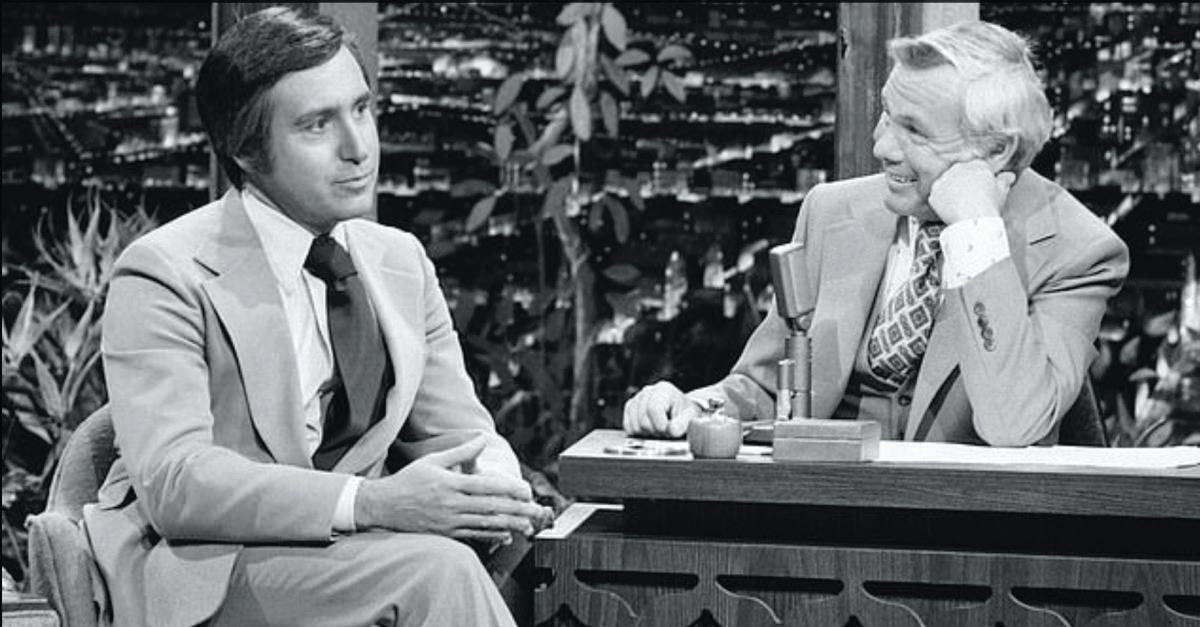
platforms [are] allowing for that to happen because it’s in their best interest to keep people engaged and on their speci c platform,” Badami said.
To keep up with the times, journalists can use social media to distribute content, nd sources and learn about their audience engagement rates, Badami explained.
But even though there are some potential bene ts to social media usage, Badami warned that journalists have to be selective about the platforms where they publish their content and think about balancing visibility with distribution.
Amanda Horowitz has already started thinking about the best platforms to use to disseminate her late father’s consumer advocacy messages, she said. On apps
like TikTok, it can be hard to predict what content will be agged as a community guidelines violation, she said. As a result, she said she has started to shi to YouTube, which she thinks is currently the friendliest platform for journalism.
No ma er the platform, Amanda Horowitz said she is commi ed to delivering David’s wisdom.
“Our intention is to provide our community with engaging content, and I’m commi ed to doing that,” Amanda Horowitz said. “I’m going to continue doing that and just problem solve these things along the way.” Clari cation: is story has been updated to include Amanda Horowitz’s graduation year.
marissafernandez2028@u.northwestern.edu
By LYDIA PLAHN dail( -e)ior -!affer @lydiaplahn.3
Keeping track of all the wild characters and costume changes in the Virginia Wadsworth Wirtz Center for the Performing Arts’ production “Museum” is a near-impossible challenge as 40 di erent characters take the stage, each one more eccentric than the next.
“Museum,” a .9:9 comedy by Tina Howe, centers on an art exhibit’s last day at a ctional museum.
e exhibit, “ e Broken Silence,” highlights three artists and their modern, outlandish art. e show’s cast of .@, a combination of Northwestern undergraduate and master of ne arts acting students, play three security guards and 3: patrons of the museum, showing the quirkiness of humanity through larger-than-life characters.
e show opens with a stunning set, void of actors until a lone security guard takes the stage. Soon a er, a hip, young photographer arrives at the exhibit determined to photograph the art. e rst couple minutes are completely silent as the photographer dramatically struggles to set up his camera and tripod in silence, just for the security guard to tell him that the museum does not allow people to photograph the art.
Interactions and comedic moments like this one are the heart of the show. “Museum’s” humor is largely physical, driven by outlandish gestures,
over-the-top characters and comedic voices. ese choices give the show an improvised feel, as some of the deliveries are so ludicrous and zany that it seems impossible to be rehearsed.
Communication MFA student Kyle Ringley, who plays the main security guard, never misses with his comedic deliveries. Additionally, Communication MFA student Sharon Miles, who plays three roles, is a powerhouse who is never overshadowed by the various actions occurring on stage. is production mostly nds laughs but at other times becomes so caught up in absurdity that it struggles to maintain humor. Because the show does not have a linear — or really any — plot, the show drags, and the foolishness of the characters feels exaggerated instead of enduring.
“Museum” is primarily held together by the ability of the actors to transform seamlessly from one of the 40 characters to another. With so many di erent costumes, personas and wigs for each actor to wear every night, one might expect li le slips where characters blend together, but not once does that happen.
e costuming by Josie Evere adds fun and whimsy. e actors are adorned with big collared shirts, plaid suits, heeled leather boots and stunning dresses. ese costumes feel like they themselves could be a museum exhibit about the .9:0s, a testament to Ever ’s clear vision. Not one bracelet or hairstyle feels forgo en; everything looks perfectly curated.
At its core, “Museum” is a 90-minute allusion
to life itself. e show hints that we are all — like the patrons of this ctionalized museum — just living our lives with no idea what is going on. Like the characters, we fall in love, name-drop, steal things and break down all in the name of trying to gure it out.
But at many points, “Museum” seems to lose this focus and leaves the audience with more questions
than messages or themes, causing me to wonder if such heightened levels of absurdity was the best directorial choice.
“Museum” runs at the Wirtz Center through Feb. .6, o ering an interesting but unfocused commentary on life through art.
lydiaplahn2027@u.northwestern.edu
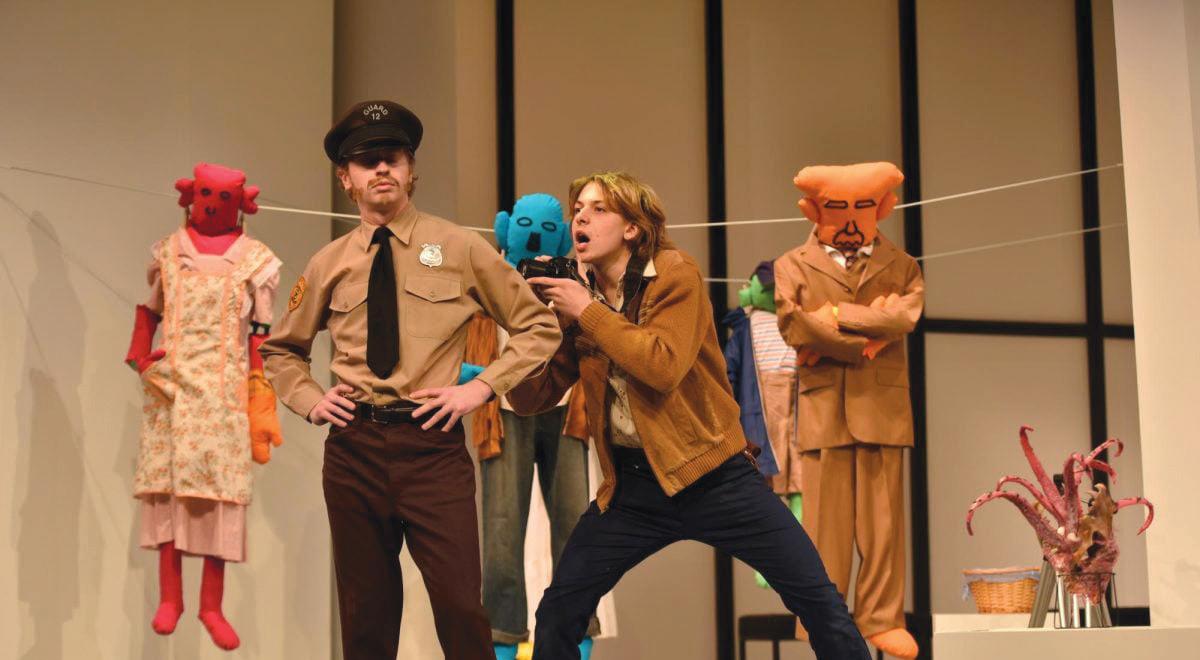
By DALTON HANNA dail( -e)ior -!affer
@daltonhanna06
Three student playwrights will have the chance to spotlight their scripts at Vertigo Productions’ annual Winter Reading Series this weekend.
The Winter Reading Series features minimal tech in each performance, allowing audiences to focus entirely on the writing, Weinberg junior Nathan Gilbert explained.
“You’re seeing the skeleton of these shows,” said Gilbert, who is one of the playwrights. “It’s theatre in its purest form. You get to see the work in its imperfect totality, which is just really beautiful.”
This year, the play lineup includes “Itinerary” by Gilbert, “Crashing In” by Communication senior Kailey Morand and “Eternal Ellipsis” by Weinberg junior Zakrya Ashby. Rehearsals for the readings started at the beginning of this quarter. It’s a secondary process, which means there are fewer rehearsals and the production is a smaller time
commitment than primary-process student shows.
Communication junior and Vertigo President Nora James Eikner is acting in Gilbert’s play at WRS. She said she’s enjoying seeing each of the shows selected last spring come together.
“My favorite thing about Winter Reading Series is that you get to see the vastness of writers’ minds at this school,” Eikner said. “There’s this beautiful overlapping of different perspectives and stories, and because it focuses so much on the work and not on the production, it’s such a beautiful way to get more writers’ voices and their plays put up.”
Because of this added emphasis on the writing, Gilbert said watching and listening as his work is read aloud to an audience is “a scary jump to make.” Gilbert took a gap year after a difficult freshman year and said a lot of his moments and characters in “Itinerary” were taken from his own experiences, making the play personal to him.
Sharing his work is “really rewarding,” despite the fear, Gilbert said. Ahead of the reading, Gilbert shared how he’s watched his
play take on a life of its own.
“One of the biggest challenges has been recognizing that ‘Itinerary’ is not my show anymore,” Gilbert said. “It will say ‘By Nathan Gilbert,’ but it becomes a collaborative process.”
This collaboration is aided by those on the production team. Communication junior Orville Amankwah is the producer for all three of the productions. This is their first time taking on this type of role, she said.
Amankwah serves as a liaison between the production and creative teams of the series, which she said is a show, unlike the average Northwestern theatre production.
“They are new stories written by students with something to say,” Amankwah said. “It’s not a perfect, polished product, and so rarely at Northwestern we get to see something in progress. It’s not fully produced, and that’s what makes it all the more loveable to me.”
Vertigo is hosting the series in Shanley Pavilion on Feb. .3 , .4 and .5 at : p.m. and .0 p.m. each night.
daltonhanna 2028 @u.northwestern.edu

ALEXANDER HERNANDEZ GONZALEZ OPINION EDITOR
Ever since I was litle, I have always enjoyed and wanted to do things on the spot. Let’s go to the nevería? I’m there. Do you want to go to the Rauw Alejandro concert tonight? Say less. Would you like to go to the rodeo with your dad and your brother? Yes, just give me 10 minutes to get ready. I truly enjoy the unexpected. It brings unique and fond memories that I’m still able to look back on. Te idea of not having a set agenda and actively making plans on the spot is not just a skill, but a trait that has helped me throughout my life. Going to hot pot with my high school speech and debate team afer a 13-hour competition, driving on Interstate 225 while listening to corridos with no set destination and making surprise appearances at family events are some of my favorite moments that weren’t ever set in stone. No, I don’t solely enjoy spontaneous experiences because I am a Gemini, I enjoy them because I like unpredictable, curious and new
encounters that I haven’t come across before. Being open and adaptable is key to this trait, especially if you want to master it.
Yet, as I transitioned to post-secondary education, I found it difcult to grasp how I can stay on track with my schedule and spend time with friends at the same time, especially as my plans would consistently change on a regular basis.
Four classes, executive positions in every organization I am involved in, a part-time job, an internship, loads of readings and homework, interviewing for summer internships, writing pieces, calling my family to make sure they are OK and working on projects outside of Northwestern are just the tip of the iceberg of what my life has become recently.
A few weeks ago, while I was working on an article about fashion designer Cristóbal Balenciaga at my internship, my editors asked me if I was interested in atending New York Fashion Week. Not only did I light up with happiness at this ofer; I was immediately hit with the reality that midterms were on the horizon, and I would probably have to decline this incredible opportunity.
Sadness, grief and yearning were emotions that hit me hard. I am not just a fashion fanatic, but this opportunity would allow me to see if fashion
journalism is something that I want to do afer graduation.
I thought about whether I should say yes on the spot or actually think about it fully, since I am in a diferent position than I was pre-college. Tis thought haunted me for days, and with school becoming a reason for stress, I couldn’t keep it to myself anymore.
I called my parents and asked them for some guidance. Tey asked if I was able to complete my work earlier so I wouldn’t fall back on schoolwork.
Afer I got approval from my family, I felt like a litle kid again. I was going to live out one of my bucket list items, I had spontaneity back in my life.
Waking up at 3 a.m., taking a fight from Chicago to Newark, New Jersey, and exploring New York City at noon was the best way to start this trip, as I have never been to the fashion capital of America. Tis was a solo trip, which allowed me to explore as much as I wanted.
Exploring new places, especially by yourself, can be a scary experience for anyone. But, with spontaneity, you can do your research on what’s around you, what you should visit and why you should go. It provides comfort and new learning experiences, which is always benefcial.
Even the idea of atending fashion shows in
person with celebrities, social elites and wellestablished fashion journalists scared me to death. But, thanks to my spontaneous side, I was able to make conversation with those that I looked up to and establish connections with them.
From seeing Sam Smith, Kesha and Anna Delvey at the Christian Cowan show to meeting fashion designer Willy Chavarria at Dover Street Market and telling him that he is the reason why I want to be in the industry, these moments are ones that I cherish heavily and motivate me as I move forward.
So, the next time you are debating whether you should go to a new place, do it! Make sure that you are either with friends or are staying vigilant to your surroundings, do things that make you happy and embrace the spontaneous. Trust me, it was a lifesaver and much needed, especially as things can get heavy in life sometimes.
Alexander Hernandez Gonzalez is a Medill sophomore. He can be contacted at alexanderhernandezgonzalez2027@u.northwestern.edu. If you would like to respond publicly to this op-ed, send a Leter to the Editor to opinion@dailynorthwestern.com. Te views expressed in this piece do not necessarily refect the views of all staf members of Te Daily Northwestern.

On Passover, the Jewish holiday commemorating the deliverance of the Israelites from slavery in Egypt, the youngest member at the Seder celebration is called to introduce the service.
Te prayer, known as the Four Questions, is meant to symbolize the transmission of the Passover story to the next generation, with the traditions of the Seder plate used to illuminate the story.
“Why is this night diferent from all other nights,” the child begins, “Tat on all other nights we eat both chametz and matzah, on this night we only eat matzah?”
You come to learn throughout the ceremony the answers to the Four Questions. Matzah because in their Exodus the Israelites had no yeast to leaven their bread. Te biter herb, maror in Hebrew, to invoke the biterness of Egyptian slavery.
While we make praise for the fact that we have endured, Judaism teaches us to constantly return to the stories of our struggle — in the spirit of celebrating our triumphs, yes, but also because they remind us of that which our status as God’s chosen people cannot immunize us against: antisemitism.
It is the only constant. No mater the circumstances of the world outside our practice of Judaism, the struggle of Jews against antisemitism comprises
a certain inevitability. Perhaps more than any lesson that can be learned from the Holocaust and our persecution throughout history is that Judaism is less like a religion by choice than it is a race by proxy.
I rarely atend synagogue. Tere is a joke in my family that I have become “disconnected” from my congregation. But alongside them, I would be ripped from my home and sent to Auschwitz.
Jewish tradition instructs us to question our surroundings — the conditions, circumstances and at times our own apathy — that lead to our sufering. Tis is why, as the Israeli Prime Minister grinned at the notion of creating a “Riviera of the Middle East,” I struggled to reconcile my support for the Jewish state with the recklessness of its leaders’ rhetoric
If you cheered this proposition, you have become so distracted by the mind-boggling irrationality and brutality of antisemitism that you have decidedly overridden the lessons we religionize over.
You are asking only one question, about what convinces antisemites of that particular worldview. Perhaps you comfort yourself by musing about how they were raised to hate Jews and deny the Holocaust. Tat they’re confused and uninformed about the enduring confict between Israelis and Palestinians and the Zionist ethos. Tese things might even be true. But in terms of our fght against hatred, the answer to this question maters not.
Today, drivers of Israeli-Palestinian relations — members of the Israeli and American governments and their allies — have ceased to ask questions. And they do so under the guise of fghting a root cause of antisemitism that they may never uncover.
When we are cyclically called to question our history — to remember the sufering of our ancestors — it is not the antisemitism itself that makes these stories important. It is about being reminded that we have been defenseless before.
We are called to acknowledge, not proselytize, the irrationality and intemperance of antisemitism. We know that if only they knew more about how beautiful our religion, its people and culture are that they could never in good conscience be antisemites.
In engaging in good faith with the Jewish tradition, you get to the throughline of our sufering. We must carry on because our oppressors pick on us to avoid picking on someone their own size.
Hamas had no justifcation to carry out the atrocities of Oct. 7 and condemn hundreds of men, women and children — mothers, fathers, sisters, brothers, friends — to starvation and captivity as “negotiation tactics.” Many of us are close to this particular sufering in Israel and Gaza today. But part of compartmentalizing the immense pain of antisemitism and the evil of bigotry everywhere is the inherently Jewish understanding that the unnecessary sufering of others only makes ours greater.
Te Gaza Strip is roughly the size of Manhatan, the Bronx and Hoboken, New Jersey. Last week, the leader of the most powerful nation in the world threatened to erase its Palestinian history and replace it with a Mediterranean resort town for the world’s leisure. Where will the Palestinians go? He’s not sure.
If the careless rhetoric with which this confict has unfolded continues, I fear we are headed toward a future where antisemitism is not only acceptable in

Growing up, I’ve had several teachers tell me it’s not “The Sylvie Show.” The most notable time was in middle school during a game of kickball. The teacher was a mid- 30 s hipster from Brooklyn with long brond hair and Warby Parker glasses. A lot of the girls at my school had a crush on him. Or maybe just I had a crush on him -– I don’t remember.
I do remember my cheeks getting really hot when he said that. If he thought I was being too much of an attention whore, couldn’t he have said it to me while I was passing the pitcher’s mound from the outfield for my at bat (… at kick?) like, discreetly?
It really hurt my feelings that someone would suggest I thought everything was about me, even though I put myself out there all the time. One of the worst things you can be in society is a narcissist, and I was just outed as one. When the idea of writing my own column became a reality, I was worried
people would be like, “Who is this Sylvie girl?” “Why does she get her own Column?” and “What does she even have to say about anything?” We will get to the first two questions at some point, promise. But, as for the third, there are a lot of things you can say about me, but you cannot say I don’t have things to talk about. Whether or not what I have to say is relevant or interesting — I have opinions. I love to talk, that is, to speak, not converse. I also love to listen to people speak. Both can be true about a person. We have a tendency to put people in boxes, people are either talkers or listeners. We can be more than one thing — not everything is a dichotomy. There! That was an opinion.
This Sylvie girl is a Journalism major because she wants to be a television personality, think Jane Pauley. I imagine myself one day daintily clasping my fingers in front of my left hip standing in a navy sheath dress that falls just above my knees. I never got botox because my smile lines are proof I made it. Remember when I said we can be more than one thing?
I would love to have “The Sylvie Show.” I’d also love to write a memoir someday. Maybe I’ll call it “The Sylvie Book” for
consistency. I’ll write anecdotes about my childhood and incredibly niche hobbies, like baking and painting. Until then, I’ll stick with sharing my collegiate takes communal shower thoughts, if you will.
This Sylvie girl gets her own column because she asked for one. Because I believe the things I have to say and the way I say them are interesting enough that people will read them. By asking for a column, I am inherently saying I think I am a good writer, that I think I have fresh and interesting takes.
You might be like my middle school teacher. You may be reading this thinking I sound like a narcissistic bitch. But, if my biggest fault is wanting to share my thoughts and thinking people might listen, I’m good with that. And hey, you’ve made it this far, so I may just be onto something.
Sylvie Slotkin is a Medill sophomore. She can be contacted at sylvieslotkin 2027 @u. northwestern.edu. If you would like to respond publicly to this op-ed, send a Letter to the Editor to opinion@dailynorthwestern.com. The views expressed in this piece do not necessarily reflect the views of all staff members of The Daily Northwestern.
our private discourse but justifed in the mainstream. Troughout my life, I have never shied away from my Jewish identity. I am so immensely proud to be Jewish. But today, like many others, I fnd myself thinking twice before revealing it. When history threatens to repeat itself, I imagine it will frst condemn us to this kind of shameful overthought.
“How is this night diferent from all other nights,” the child continues, “Tat on all other nights, we eat either siting upright or reclining. Why on this night do we all recline?”
Te answer is revealed as the spoils of our Exodus. We recline, because by virtue of being alive and Jewish and with one another in this moment, we must no longer be slaves in Egypt.
But coming together throughout the year to tell the same stories and to ask the same questions, this is our responsibility in freedom. Because when we do so we fnd Judaism’s most valuable asset: a potent empathy for those whose struggle is like ours.
An empathy not for terrorists and hostage-takers but for the defenseless men, women and children who stand to lose their homes, culture and dreams of a Palestinian state to a “Riviera of the Middle East.”
People who, like us, have no choice but to keep a hope for their deliverance alive and endure.
Aidan Klineman is a Medill sophomore. He can be contacted at aidanklineman2027@u.northwestern.edu. If you would like to respond publicly to this op-ed, send a Leter to the Editor to opinion@dailynorthwestern.com. Te views expressed in this piece do not necessarily refect the views of all staf members of Te Daily Northwestern.
The Daily Northwestern Volume 148, Issue 5
Editor in Chief Lily Ogburn
Opinion Editor Alexander Hernandez Gonzalez
Assistant Opinion Editor Alice Oh
Managing Editors Henry Frieman Lexi Goldstein Betsy Lecy Emily Lichty Kelley Lu Jillian Moore
LETTERS TO THE EDITOR may be sent to 1999 Campus Drive, Evanston, IL 60208, via fax at 847-491-9905, via e-mail to opinion@ dailynorthwestern.com or by dropping a letter in the box outside THE DAILY office.
Letters have the following requirements:
• Should be typed and double-spaced
• Should include the author’s name, signature, school, class and phone number.
• Should be fewer than 300 words
They will be checked for authenticity and may be edited for length, clarity, style and grammar.
Letters, columns and cartoons contain the opinion of the authors, not Students Publishing Co. Inc. Submissions signed by more than three people must include at least one and no more than three names designated to represent the group.
Editorials reflect the majority opinion of THE DAILY’s student editorial board and not the opinions of either Northwestern University or Students Publishing Co. Inc.
From page 1
as well as those that endorsed other candidates, to foster meaningful change on campus and strengthen the connection between ASG and these groups.
In discussing his vision for a more connected and approachable administration, Omoniyi also shared his plans for promoting better communication with the student body to ensure anyone can approach leadership with questions about ASG, the presidency or to voice their concerns.
“One of the big weaknesses of ASG (is) people don’t know their senators. They barely know their presidents,” Omoniyi said. “Because of that, we’re not really useful if we’re not getting their ideas and their input.”
La Fayette Jr. and Omoniyi expressed their gratitude to the other candidates for their contributions to the election.
The pair invited them to the table to talk about their ideas in order to best serve them and their communities in this next administration, La Fayette Jr. said.
“The ideas that candidates came in with were very valuable, and they resonated with the student body,” La Fayette Jr. said. “I don’t think that those ideas should be left at the door or
From page 1
I have my own will,” Mundy responded.
Davis, who has pledged to boost transparency and resident input, seized on the Ryan Field uproar when she launched the “Beter than Biss” commitee in 2023 seeking to topple the mayor over his support for NU’s plans. She now supports Boarini.
Vying for the open 7th Ward seat, Davis faces Mundy, who painted a brighter picture of current-day Evanston. Tings are “not all bad” here, he said at the forum. Mundy has garnered fnancial support from former mayor Steve Hagerty.
Following Ald. Devon Reid’s (8th) solo showing, Ald. Tom Sufredin (6th) took the stage.
Soon after introducing himself, Suffredin launched a defensive salvo against his challenger, Candance Chow, who had accused him Thursday of being a “walking conflict of interest.” Suffredin, who also works as a lobbyist, maintained that he has never received an ethics complaint.
“Tere you are, Candance,” Sufredin said, spoting her in the audience and challenging her to fle a complaint. “If you have evidence of any sort of confict of interest, go right ahead.”
die with this election.”
SESP sophomore and Election Commissioner Eliza Marcus reported to The Daily that multiple candidate teams received campaign violations during this election, which prevented them from campaigning before the official campaigning period ended. However, she said a majority of these allegations were “found to be fabricated.”
Marcus noted that the election became highly competitive and “boundaries were pushed.” Looking ahead to future elections, she emphasized the need to address ambiguity in the guidelines, adding that there was confusion among candidates regarding aspects like ranked-choice voting and definitions of harassment or bribery.
Still, Marcus said she hopes several goals will be accomplished with the new presidency.
“I hope to see the promises that were talked about during the debate come to fruition and really a more active student body-ASG relationship,” Marcus said. “I really hope that the students are able to really have a clear view of what’s going on in their administration and feel included and heard.”
janellemella2027@u.northwestern.edu
Afer a scheduling snafu, the candidates had diferent slots at the forum. Chow looked on as Sufredin then accused her of unethical behavior.
He questioned her ties to Tracy Quatrocki, the publisher and executive editor of the Evanston RoundTable. Quatrocki co-founded the recruiting frm NextGroup with Chow and others.
“In 2020, I stepped back from my management role at NextGroup to assist with the RoundTable’s transition to a nonproft, and in 2021, I fully resigned, though I have retained a small ownership stake in the company,” Quatrocki wrote in a statement to Te Daily.
As of Feb. 11, NextGroup’s website still lists Quattrocki as a co-founder and adviser.
Te RoundTable has also covered the 6th Ward race. Its Feb. 6 story on Chow’s confict of interest accusations did not mention the ties between the two.
“We have published one story up to this date about the 6th Ward race, and we stand by it from a standpoint of fairness toward both candidates and balance,” Quatrocki also said in her statement. “However, to ensure journalistic integrity, I have proactively recused myself from editing any coverage related to the 6th Ward council race.”
Future coverage will include a note explaining this

decision, she added.
Sufredin has staked an independent streak on City Council. He strongly opposed NU’s Ryan Field plans. Along with Ald. Clare Kelly (1st), a prominent Biss critic, Sufredin ranks among only two council members who haven’t endorsed the mayor.
“I’m not a person who’s going to just go along to get along,” he said. “When I think something’s wrong, I’m going to say it.”
Meanwhile, Chow has the financial backing of Hagerty and has pledged to “bring solutions, not just criticism” to City Council. During her slot at the end of the forum cohosted by Where The People Meet TV and The Daily, she responded to Suffredin’s accusations. Quattrocki has no day-to-day role at NextGroup, she added.
Occasional digs showed up in the other ward debates. When Biss and Boarini walked up to the stage, however, they smiled.
Each man represents opposing visions for Evanston’s future.
Biss rode a landslide 2021 victory to push various reforms, including the contentious Envision Evanston 2045 overhaul of city policy. Te longtime lef-wing organizer has sought to burnish his political credentials as well as his six-fgure war chest.
Afer Biss’ four-year reign, Boarini has pledged to usher in a new era of transparency from city leaders. He has frequently excoriated Biss for his Envision Evanston plans.
Te mayor ofered a more conciliatory tone on Envision Evanston, looking back to when he once called it “immoral” not to move quickly. He called it a “really stupid thing that I said” and added that the city erred in its choice of consultant for the sweeping project. Boarini, too, faced some criticism. A young audience member asked him to justify his jabs at Biss during the forum.
“I don’t believe I was being disrespectful to the mayor,” Boarini said. “I believe I was using his words and his actions.”
Te question of civility percolated in Ald. Jonathan Nieuwsma’s (4th) mind as the forum wrapped. In remarks to Te Daily, he blamed the biter tone of national politics and urged Evanston to “engage in a civil dialogue.”
Te broadsides did not fully dominate the forum. When Biss and Boarini wrapped their discussion, they shook hands, grinning.
shungraves2027@u.northwestern.edu











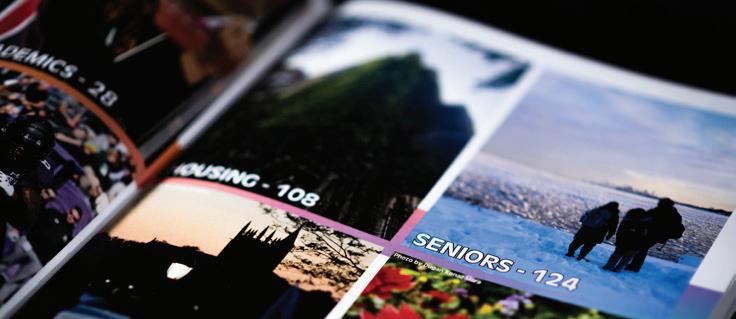

By JAKE EPSTEIN
daily se(i)r sta,,er @jakeepste-n
In the fall of .006, Miles Osei stepped into a state powerhouse football program as a freshman at Prospect High School. He bided his time for one season, stepping into the starting role as just a sophomore ahead of the .007 campaign.
Moments a er Osei secured one of his rst victories as a starter, the le -handed quarterback felt a tap on his shoulder as he recollected his breath in the locker room.
Osei looked up and locked eyes with Brent Pearlman, the longtime Prospect head football coach who amassed -03 victories during his tenure. Pearlman hadn’t started an underclassmen signal caller in nearly -0 years, but Osei commanded the three-time state champion coach’s a ention long before he cracked his varsity squad as a freshman.
“Coach Pearlman pulled me aside and said, ‘You can take this thing as far as you really want to go,’” Osei said. “It was going to be a lot of work, but at that moment I realized I could do something that as a quarterback hadn’t been done before in (school) history.”
Ever a keen evaluator of talent and potential, Pearlman sparked a re in his young quarterback during that fateful Friday night in Mount Prospect. Osei rose to statewide and regional prominence as a dual-threat passer, earning a scholarship to the University of Illinois.
Following his playing career, Osei shi ed into the coaching sphere, earning a head coach job at Elk Grove High School at just .3 years old. Six years later, he moved downstate to become the head coach at Kankakee High School in .0.3
Now, Osei has forged a new path, becoming the head coach at Evanston Township High School. e move, announced Jan. .5, lls a vacancy le by Mike Burzawa’s resignation following -7 years at the program’s helm.
For ETHS Athletic Director Chris Livatino, the Wildkits weren’t in the market for a run-of-the-mill candidate.
e hiring commi ee targeted a dynamic leader.
“He impressed myself and our commi ee right from the very rst interview,” Livatino said. “He checked all our boxes, and then some.”
With the hiring, Osei became the rst Black head coach in program history. e 3.-year-old is no stranger to breaking barriers, having been the rst-ever Black starting quarterback at Prospect and the rst-ever Black
head coach in the Mid-Suburban East Conference.
Osei said he looks at his ability to provide representation for younger athletes of color as a “unique opportunity” he won’t take lightly.
“One of the players I met the rst day said, ‘It’s cool that someone who looks like me is our head coach,’” Osei said. “ e weight of that comment absolutely locked me in.”
While his collegiate and postgraduate careers have revolved around the gridiron, Osei’s first love was baseball.
Osei rst crossed Prospect baseball coach Ross Giusti’s radar as a middle schooler, but he entered rari ed territory in .007. Giusti, who eclipsed the 500 career-win mark in .0.3, said Osei is one of just two players to ever crack his varsity team as a freshman.
“He was a ve-tool athlete,” Giusti said. “I tease him all the time that he probably could have taken baseball as far as he wanted to. He had every tool that you needed to be a Division I baseball player.”
Osei said playing football, basketball and baseball throughout his childhood ensured he’d never burn out, as he’d always pick up a second wind whenever it came time to transition from one sport to another.
e transition from baseball to football over the summer before his sophomore year illuminated a lo y path for the future Fighting Illini athlete. Pearlman said Osei seized the opportunity ahead of him and — though he experienced some early growing pains — his ability on the football eld made for must-see action.
“He was like having another coach on the eld,” Pearlman said. “He’s one of those guys that was courageous enough at that moment to lead.”
John Coen, who played both football and baseball with Osei and later signed to the University of IllinoisChicago as an in elder, said Osei’s intensity and work ethic on a day-to-day basis made him a model to follow.
Coen pointed toward Osei’s on- eld intelligence as an a ribute that jumped o the charts.
“Miles was just a sponge,” Coen said. “He had this laser focus.”
By the time Osei’s senior year of high school arrived, he had garnered several Group of Five football o ers. But Pearlman designed a new o ense for Osei’s nal season at Prospect — the Miles Only Back eld.
After tallying 6,9.4 total yards and 77 touchdowns during his junior and senior seasons, Osei received a late offer

Students Publishing Company, Inc. manages and guides the long-range planning of The Daily Northwestern and the Syllabus Yearbook. We have two–three student board member positions beginning Spring ‘25. Undergraduate and graduate students are encouraged to apply. The Board meets approximately two times per quarter.
For an application, contact Stacia at s-campbell@northwestern.edu.
from Illinois. It was an opportunity he couldn’t pass up.
Although Osei managed to log enough action to avoid a redshirt as a true freshman in Champaign, the former All-State honoree occupied a reserve role on the depth chart. He served as the backup to Nathan Scheelhaase, who is currently the passing game coordinator for the Los Angeles Rams.
Scheelhaase and Osei both carried four years of eligibility into the 2010 season, so playing time appeared at a premium for Osei. He told his coaching sta that he wanted to help the team win games in any way possible. First, he joined the kicko return unit as a sophomore in 2011 en, he shi ed to wide receiver as a junior.
“ at’s a lot of the unseen behind-the-door stu that gets missed by a lot of people,” Osei said. “You go from being that person that everybody relies on to someone that just has to be ready to go at every snap.”
As fate would have it, Osei’s most productive game as a pass catcher occurred just minutes away from his newfound stomping grounds: at the old Ryan Field.
On Nov. 24, 2012, Osei hauled in three receptions for (4 yards during a )0-14 loss to Northwestern.
e Mount Prospect native, who occupied a Swiss army knife-esque role for the Fighting Illini, recorded 77 rushing yards, 177 passing yards, 21( return yards, (99 receiving yards and a touchdown reception during his collegiate career.
Osei didn’t have to wait long for post collegiate possibilities to present themselves.
Just months a er receiving his college diploma, Osei joined Pearlman’s sta at Wheeling High School as an assistant football coach.
“I’d have given him a coaching job right out of high school,” Pearlman said. “He’s just that type of leader. I just saw a guy that demanded respect, a guy that was extremely organized..”
Just as Pearlman entrusted a then-sophomore Osei with his o ense in 2007, he handed o ensive play-calling duties to Osei during his second year on the Wheeling sta
Soon enough, Osei’s stock soared high enough to land his ,rst head coaching job at Elk Grove in 2017. In the two seasons prior to Osei’s hiring, the program went 2-2). In 2022, Osei led the school to its ,rst 7A state playo appearance since 201(
During that 2022 season and playo appearance,
Pearlman served as Osei’s assistant coach. at was probably one of my favorite years of coaching I’ve had all time,” Pearlman said. “Miles is an original. He’s a copy of nobody.”
Osei, who went 21-( during his two-year stint at Kankakee, said much of the ETHS job’s allure centered around ,nding long-term stability for his family. He and his wife Susie Osei lived in Evanston during the earlier stages of Osei’s coaching career. Now, Osei is moving his high school sweetheart and two daughters back to a community that he said has always felt like home. He added that he could see himself coaching at ETHS for decades to come. “ ere has been an incredible amount of hours put in,” Osei said. “ e only way you can make it work is when you put your family right where you work and make them part of the program. At the high school level, you can make the community school immersed into your family.”
As he guides the Wildkits into a new era, Osei has reinforced that the ETHS squad is not his program, but rather belongs to every student-athlete and coach on the team.
Osei’s vision made an instant impression on Wildkit receiver Canaan Handcox. He said his teammates have quickly embraced their new head coach.
“He wants to make sure he has a great coaching sta by his side and that everyone is on the same page,” Handcox said. “Our o season is going to look a lot di erent than it did the last couple of years.”
Despite his young age, Osei said 10-plus seasons of high school coaching have presented him with a bevy of lessons he’ll lean on as he attacks his new role.
Osei said his process will start with assembling a passionate and knowledgeable support sta that will maximize what he considers a core group of players “that wants to be really good.”
“My goal is to make (ETHS) one of the most respected programs in the state,” Osei said. “It will be a lot of work, but I truly believe Evanston has all the resources, all the kids needed to make that happen. We just need to circle the wagons, make sure that the kids who live in Evanston stay at (ETHS), make sure we develop those who are already here into great teammates and great people.”
jacobepstein2026@u.northwestern.edu
































By ANAVI PRAKASH daily se(i)r sta,,er @anavi_-.
/e Evanston/Skokie School District 6- Board of Education heard updates related to its Structural De cit Reduction Plan at its Commi ee of the Whole meeting Monday.
/e board also unanimously approved a $-6,000 contract for Student-Centered Services — the group that consulted on Phase . of the SDRP — to advise the district on Phase 3 of its plan.
District 6- conducted a demography study in .0.4 to look at post-pandemic enrollment and the district’s new school boundaries, which will take e ect when the Foster School opens in the .0.6-.7 school year.
Enrollment is expected to decrease by 401 students from scal year .0.- to scal year .030, according to the report.
Stacy Beardsley, assistant superintendent of curriculum and instruction, said the decrease can be a ributed to low housing turnover and the increasing median age of Evanston residents. She added that there are fewer K-8 aged children to ll district classrooms.
By the .0.9-30 school year, enrollment numbers will stabilize around -,400 students, according to the report. Board member Soo La Kim said this is helpful to plan ahead in regards to the SDRP and beyond.
“As we have to make some really hard decisions, having the most accurate data and understanding the platform of where we are is going to be hugely important,” Superintendent Angel Turner said.
/e district’s current enrollment levels for each grade range from about 69% to 83% of possible students. Beardsley said eighth grade has the lowest enrollment because the district didn’t recover from losing about 10% of those students during the pandemic.
/e report also showed that District 6- has the most schools — 16 of them — compared to nearby K-8 districts with similar enrollment numbers. Crystal Lake Community Consolidated School District 47, which has about 7-0 more students than District 6-, has 1. schools.
Donna Cross, executive director of research, accountability, assessment and data, presented on the district’s equity progress indicators.
Student belongingness for grades - to 8 increased from -1% in the .0.3-.4 school year to -8% in the .0.4-.- school year.

For grades 3 and 4, engagement levels decreased from -8% to 48%, which Cross called “a bit of a shock.”
Twenty-one percent of Black students in these grades also said they felt like they barely or did not belong in the district — the largest percentage of all the racial groups measured, Cross said.
Academically, fewer seventh and eighth grade students are below the .-th percentile in English Language Arts. Compared to last winter, however, the percentage of students meeting the “Expected Growth” benchmark decreased from 69% to 49% in math and 6.% to -3% in ELA.
Board member Joey Hailpern said there needs to be expectations set for the district to help improve these numbers.
“/is is all about an experience that’s supposed to change the trajectory of kids upward,” he said. “It all comes back to expectation and execution, and a lot of that is communication.”
At the early childhood level, students are evaluated using Cognitive ToyBox, a ve minute game that
measures knowledge including vocabulary, reading comprehension and identi cation of upper and lowercase le ers, said Narishea Parham, director of the Early Childhood Center.
64% of students meet or exceed age-level expectations overall. Twenty-two percent of students are doing the same for reading comprehension, an 11% increase compared to the beginning of the school year.
Parham said based on this data, teachers are asking students more “Wh” — who, what, where, when and why — questions.
“(We) have them begin to truly explain, when we’re reading in our stories, the se ing, what does that mean? Basic character analysis and things of that nature to help see if the students truly understand reading comprehension,” Parham said.
/e board also chose to revisit a conversation about continuing to have the Infant Welfare Society of Evanston as a subrecipient of the district’s Early Head Start funding. Under-enrollment in both the district and IWSE could jeopardize the district’s funding,
Several board members want to keep funding the IWSE, but the question is for how long.
Hailpern said that when the district is in a be er nancial state, early childhood education — including the collaboration with IWSE — could expand. Right now though, it is crucial for the district to serve the families who are currently part of the district and utilize IWSE programming, he added.
Board president Sergio Hernandez emphasized applying teaching methods that are working to all classrooms so that students’ academics aren’t lost as they transition to di erent grade levels and schools.
“ /ose are places that as a system, we should always try to be cognizant of, particularly for our most marginalized students,” Hernandez said. /at is where we tend to lose ground.”
anaviprakash2027@u.northwestern.edu

Wednesday, February 12, 2025
By SIDDARTH SIVARAMAN
the dail( )orth,e-ter) @sidvaraman
Northwestern wrestlers lingered in the northwest tunnel of Welsh-Ryan Arena long a.er an emphatic 27-12 win over Michigan State Friday night, signing autographs for a crowd of young fans. It was a ing end to a dual meet that gave the home support much to cheer about.
“ is was the kind of night we’ve been looking to have for a li le while now,” NU coach Ma Storniolo said. “ e message to the guys going into this and coming out was [that] a itude, grit and e ort go a long way, especially at this time of year, and that’s what you saw.”
e Wildcats (3-6, 1-5 Big Ten) overpowered the Spartans in seven of ten bouts. e night started with one of the few matchups lopsided in the visitors’ favor, as redshirt junior 174-pounder Aiden Vandenbush fell in a 14-3 major decision to Michigan State’s Ceasar Garza.
From there, graduate student 1:4-pounder Jon Halvorsen set the tone for NU with a gri y 3-2 decision win. Halverson’s riding time advantage a.er two overtime tiebreaker periods put the ’Cats on the board in a match Storniolo described as “far from pre y.” at re burned even brighter in the 197-pound bout, a ranked matchup between No. 13 redshirt junior Evan Bates
and Michigan State’s No. 25 Remy Co on.
Bates made quick work of Co on, taking him down twice before pinning him in :4 seconds and rising to his feet to re up the Welsh-Ryan Arena crowd.
“It felt pre y good in the moment,” Bates said. “I’ve been dealing with some things — a li le sick today, and I kind of felt a li le sorry for myself, so it felt good to go out there and get the pin.”
Redshirt freshman heavyweight Dirk Morley lost his bout to Michigan State’s Max Vanadia by technical fall, providing a brief reprieve for the Spartans in the Wildcat onslaught. NU ra led o ve straight wins from there, writing its rst conference dual win of the season in stone.
Redshirt freshman 125-pounder Dedrick Navarro secured his fourth-straight dual win with a 13-2 major decision victory before sophomore 133-pounder Massey Odio i recorded three rst-period takedowns en route to a 14-5 major decision win over Michigan State’s Tristan Lujan.
In the 141-pound bout, injury-plagued graduate student Chris Cannon won his rst matchup of 2025 with a 7-3 decision over Michigan State’s Jaden Crumpler. A.er recovering from multiple shoulder injuries sustained over the last few months, Cannon wrestled without any kind of brace for the rst time this year. He said his season has been an uphill ba le, but his coaches have helped him keep a positive a itude.
“When I’m feeling good and I wrestle to my full potential, I can beat anybody,”
Cannon said.
No. 25 redshirt freshman 149-pounder Sam Cartella and No. 9 graduate student 157-pounder Trevor Chumbley continued their bids for high seeds in this year’s postseason tournaments with a 9-6 decision and a 19-5 major decision, respectively.
With No. 1: Maxx May eld out due to illness, sophomore Jacob Bostelman stepped in for a 165-pound nightcap against the Spartans’ Jay Nivison. Nicknamed “Bosco Sticks” by a row of young fans behind the NU bench, Bostelman wrestled with the same aggression that his teammates carried in the bouts preceding his. A.er trading takedowns to tie Nivison 6-6 at the end of regulation, Bostelman fell short in overtime.
“I couldn’t be prouder of Jacob’s e ort out there,” Storniolo said. “He competed with a lot of heart, a lot of grit, and he was really close to ge ing a win against a decent opponent.”
Following this win, NU will host Wisconsin in its last home dual Friday before heading to Iowa to close out the 2025 dual season.
“Wisconsin is a li le bit be er of a team than Michigan State, and Iowa is next level, but the recipe for success is what we did tonight,” Storniolo said. “You should go out there and wrestle every opponent the same, whether they’re the hundredth-best guy in the weight class or the best guy in the weight class.”
siddarthsivaraman2028@u.northwestern.edu
By ISAIAH STEINBERG
dail( -e)ior -taffer
@isaiahstei27
With just 11 seconds remaining and Northwestern holding a fourpoint lead, junior forward Grace Sullivan intercepted an inbound pass to clinch a 69 - 63 victory over Penn State, securing the team’s first Big Ten win of the season — and its first victory in 2025
Sullivan’s timely play capped off a strong team effort, with senior guard Melannie Daley adding a team-high 20 points in addition to four steals and four assists. The Wildcats ( : - 14 , 1 - 10 Big Ten) capitalized on Nittany Lion ( 10 - 14 , 1 - 12 Big Ten) miscues, forcing 24 turnovers and converting them into 21 points.
“I give our team a lot of credit,” coach Joe McKeown said postgame. “We’ve never given up.”
Held to just two points in the first quarter, Daley lit up the floor after the first 10 minutes. Like clockwork, the Hastings, New York native consistently evaded Penn State defenders to convert midrange opportunities.
The Nittany Lions had no answer.
The ’Cats rallied from a sevenpoint deficit at the start of the second quarter to a one-point lead at the buzzer thanks to Daley’s 5 -of- 6 shooting from the floor in that frame.
“We see Mel get those back-toback shots,” Sullivan said postgame. “We’re getting back on defense. We’re clogging it up. We’re in their faces. It just builds and builds and builds like a snowball effect.”
After the break, both NU and its opponents cooled off in the third quarter and entered the final period tied at 41 apiece.
Led by junior guard Caroline Lau’s playmaking prowess and sophomore guard Casey Harter’s shooting, the hosts quickly caught fire in the final frame, scoring 2: points — just two points short of their first-half total.

In the first minute of the final quarter, senior forward Caileigh Walsh and Harter drained back-toback 3 -pointers, spurring the ’Cats to a 47 - 41 advantage. Daley and Lau went coast-to-coast on fast-break opportunities in consecutive possessions, extending NU’s lead to nine with 7 : 36 to go.
As the hosts’ lead ballooned to a game-high 12 points, Penn State switched to a full-court press, forcing the NU offense to sputter. But the ’Cats adapted their strategy to maintain their lead and keep their opponents at bay.
“That’s been a big Achilles (heel) for us — our turnovers,” McKeown said postgame. “I think our record would be a lot better in the Big Ten if we could take care of

By AUDREY PACHUTA dail( -e)ior -taffer
@audreypachuta
Returning all but two members of its starting lineup from the 20232024 season, No. 20 Northwestern aimed to get its season off on the right foot, facing three ranked opponents in five games at the NFCA Division 1 Leadoff Classic in Clearwater, Florida.
The Wildcats came away with a 3 - 2 record.
In a weekend that saw the returns of graduate student pitcher Lauren Boyd and senior infielder Grace Nieto, NU showed how new additions could enhance last year’s rotation.
In addition to Boyd and Nieto, freshman infielder Kaylie Avvisato slotted into the third spot in the lineup for the final three games, leading the ’Cats offense with nine hits in 16 at-bats, including three extrabase hits.
Boyd started on the mound in NU’s season opener against Kennesaw State, pitching 5 2 innings in her first appearance in 623 days.
the ball. Our practices have been really competitive, focused on trying to take the ball in reverse. We’ve worked a lot on passing — trying to pass to your teammates, not the other team.”
McKeown’s squad averages 14 9 turnovers per game, but only lost the ball 11 times against Penn State.
As the ’Cats prepare to face fellow Big Ten basement dwellers Purdue in their next contest, McKeown hopes to carry his team’s winning momentum into the road trip.
“Purdue — that’s a place where basketball is so important and the fanbase is so strong,” he said. “You can’t do anything but go down there and be ready to play.”
isaiahsteinberg2027@u.northwestern.edu
Junior infielder Kansas Robinson and sophomore outfielder Isabel Cunnea both worked walks in the opening inning, but the ’Cats couldn’t capitalize on the early baserunners to score.
The Owls struck first in that contest, scoring two runs on three hits in the bottom of the first to put the ’Cats in an early hole.
Entering the seventh inning, the game was tied at seven, as Avvisato recorded her first career hit and advanced on a throwing error, allowing sophomore pinch-runner Hannah Cushing to score from second base. NU secured the win in the bottom of the inning after sophomore pitcher Renae Cunningham entered with one out and a runner on base, recording the save.
Later that day, coach Kate Drohan’s group fell 3 - 0 to No. 15 Missouri. NU recorded just three hits in the loss, with Avvisato collecting all three. Freshman pitcher Riley Grudzielanek pitched the entire contest, conceding only two earned runs over six innings in the defeat.
The ’Cats’ lone ranked win came in a 4 - 1 victory over No. : Duke. Boyd pitched all seven innings in the win, her most extensive outing since a victory over Iowa on April 2 , 2023 . Both NU and Duke recorded seven hits, but the ’Cats pulled away with a win thanks to a gritty defense performance.
The Blue Devils’ best chance came in the third inning when three consecutive infield hits allowed them to load the bases with no outs. But Boyd’s dominant performance limited the Blue Devils to just one run, notching back-to-back strikeouts to end the inning. Avvisato again led NU’s offense with three hits, including a double and a triple.
Following the win, the ’Cats were overpowered 12 - 1 by No. 5 Tennessee. NU’s only run came off a sacrifice fly by sophomore catcher Emma Raye that allowed Robinson to score in the first inning. Cunningham, Grudzielanek and freshman pitcher Emma Blea — making her first career appearance — split time in the circle.
Drohan’s group wrapped up the weekend with a 2 - 1 win over Southern Mississippi Sunday. Grudzielanek pitched the entire game, giving up just two hits. Senior outfielder Ayana Lindsey hit her first home run since the 2023 season in the victory.
After a successful weekend in Clearwater, the ’Cats will head to Baton Rouge, Louisiana, for five games at the Purple and Gold Challenge, hosted by No. 9 LSU. audreypachuta2027@u.northwestern.edu